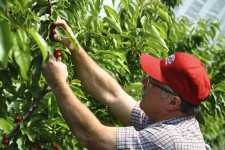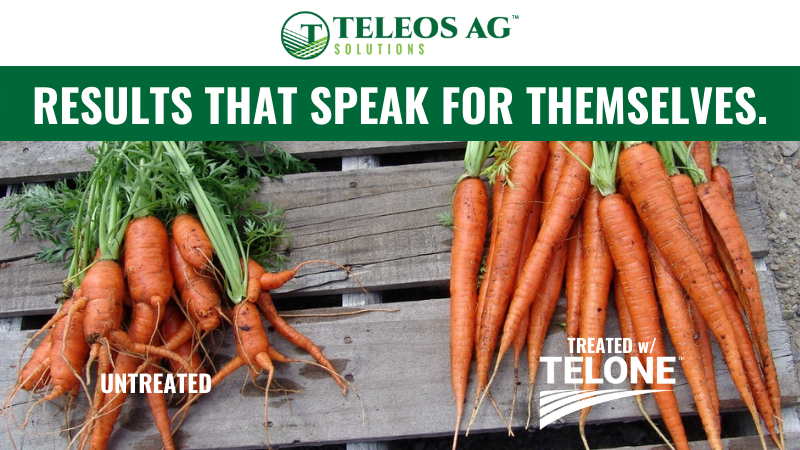Growing Hothouse Cherries In California

After a decade of trials and errors, a group of California cherry growers have developed a system for producing what they are calling “hothouse cherries,” fruit produced in a semi-indoor environment.
It’s a first for California, according to Daniel Moznett of Grower Direct Marketing, who has seen it done in Spain but by no one else in the Golden State. Chris Zanobini, the executive director of the California Cherry Board, also says he hasn’t seen it elsewhere in the state.
While getting up to speed wasn’t quick, and certainly hasn’t been easy, the payoff is sweet. The cherries can be sold for a very nice premium because they are harvested three weeks to a month before cherries grown traditionally. “Depending on the year, late March to early April,” says Moznett, Grower Direct’s director of marketing.
While he declines to state how much of a premium the hothouse cherries command, saying that it varies a lot according to when shipped and where sold, Moznett does note that they are pricey enough to get their own box. Rather than a traditional 18-pound box, these cherries, branded “GDM – Golden Standard,” are shipped in a 5-kilogram (Just over 11 pounds) box. They are shipped primarily to Asia, but also to Europe, Brazil, and some in the U.S. — anywhere people will pay top dollar.
Total Control
The cherries are grown in California’s two main cherry districts, Bakersfield/Arvin and Stockton/Lodi, and packed by OG Packing in Stockton. While they are called “hothouse cherries,” Moznett says the conditions are more like tunnels than greenhouses, though the roofs of the structures are retractable. All of it is computer-controlled, using software written especially for the system.
“We control everything, from heat to humidity, to frost and wind protection,” he says. “It’s completely different than growing externally.”
It’s so different, it took about 10 years to smooth out all the wrinkles. “Some of our growers are fourth generation,” says Moznett, “and they say they are just learning.”
Part of the reason the growers had trouble was that they had to determine the best conditions for each stage of the tree, from dormancy to pollination to ripening. While it’s terrific to be able to control those conditions so the trees could flourish, everything is intensified in that environment, says Moznett, including pest pressure.
“They’re a lot more destructive, whether bugs, mold, or any disease at all in there,” he says. “The variables are magnified inside; everything is magnified inside.”
That took some getting used to, says Moznett, adding that it’s not like they couldn’t produce crops in prior years, it’s just that they couldn’t be certain. “The biggest challenge for us is having a consistent, promotable crop — some years we’d have it, some years we wouldn’t,” he says. “You have to provide that consistency, something people can count on, and now we can do it.”
Now That’s Fast
This year for the first time OG Packing of Stockton, CA, is utilizing a new electronic cherry sorting system installed by Unitec, and it is truly an impressive machine. It has 32 lanes, and each is capable of handling 108,000 fruits per hour. Doing the math, that means when it’s operating at full capacity, it can process 3.456 million cherries an hour.
“If running at peak that should be about right,” says Daniel Moznett of Grower Direct Marketing. “We haven’t had to dial it up all the way yet, but they do go through at lightning speed.”
What might be even more impressive than the raw speed is what’s happening when the fruit is racing through, says OG Packing Plant Manager Tom Gotelli.
“It takes 30 pictures of each cherry, and when the fruit goes through the cameras the sorter deciphers what’s good, what’s bad, and what size it is,” he says. “It makes our job much simpler and it gives us a better product in the long run.”
Revolutionary
Gotelli said they started running the machine in early May, and then later that month held an open house which was attended by packinghouse representatives from California, Oregon, Washington, and Chile. The machine was manufactured in Italy, though the company has recently opened a new subsidiary, Unitec USA, in Stockton, CA.
“The Unitec Company is fantastic to work with, and when the system came, it came in seven containers and it was all assembled in the order how it was supposed to go together and it worked extremely well. They did a fantastic job, they are very professional,” says Gotelli. “Everybody is happy about it, the growers, the buyers, and in the long run it’s going to give our consumers a great product.”
The sorter offers non-destructive detection of the external and internal quality of cherries, and can grade cherries by size and color. It automatically removes debris and defects, and it’s able to select each cherry on the basis of skin defects and shape with high precision and reliability.
Cherry packers can reduce the hand labor dedicated to quality selection by manual sorting and increase processing efficiency, maximizing product quality and shelf life of cherries with marked savings in processing costs. Packers can realize higher quality standardization, better presentation of cherries placed on the market, and more added value to final product.
“We’ve been in business for more than 60 years — I’m third generation – and our family loves the cherry business,” says Gotelli. “Now we are excited to have this Unitec machine doing the electronic sorting and sizing for us. It’s a revolution that’s taking place, it’s extremely exciting, it’s doing very well, and we are very proud of it.”









